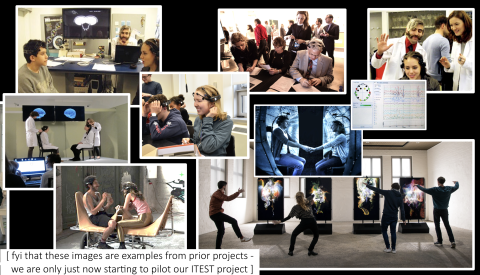Body
Image

You: Quantified
This project will promote data literacy in high school students by engaging them in learning about the Quantified Self, the practice of using technology to track and reflect on one’s own biological, behavioral, physical, and/or emotional data. Learning activities will be designed to spark a broad interest in science and to help develop students? informed opinions about the role of human-generated data in public life. To achieve this goal, the project will develop and test software tools as well as lesson and professional development materials with which students and teachers can explore, analyze, and create novel, multimodal, and interactive representations of data, recorded by wearable biosensing devices. Students will (a) learn about how data from their bodies can be captured and interpreted through hands-on STEM activities that include the creation of interactive data representations; (b) design and execute small exploration projects to answer their own questions and create offline and online artifacts to communicate their findings; (c) engage in discussions that consider the privacy implications of using data-fueled services and applications and critically evaluate how their personal data is being used. During and after the project, instructors and students will have opportunities to connect with industry partners who work with biosensing and wearable technologies, and to access career and college readiness resources relevant to these and related data technology fields.
Pillar 1: Innovative Use of Technologies in Learning and Teaching
We will combine wearable biosensing devices, an online NGSS-aligned curriculum platform, and professional development materials to support students in exploring and representing data from their brains, bodies, and behavior. Using graphing and Brain/Body Computer Interface (BCI) technologies, students will develop creative multimodal representations to support interpretations of their data.
Pillar 2: Partnerships for Career and Workforce Preparation.
We will work with leading industry partners in mobile biosensing technology; with neuroscience student organizations who will support students’ career and workforce preparation; and with digital arts organizations. Our tools will help students connect to these and other industry partners and to career and college readiness resources.
Pillar 3: Strategies for Equity in STEM Education
By offering a variety of data engagement avenues (data streaming from wearables, creative representation, remixing code, analysis, and graphs) and a guided inquiry approach, we will build on a range of students’ STEM and non-STEM interests. We will further use a participatory design approach to develop learning materials and tools in a culturally responsive way; and we will work closely with students and educators associated with the Imagine NYC Schools initiative, which is dedicated to (re)imagining public schools in N

Discipline(s)
Interdisciplinary
Target Gradespan(s)
High school (9-12)
Target Participant(s)
Youth / students
Project Setting(s)
Formal Education
Category
Developing and Testing Innovations (DTI)